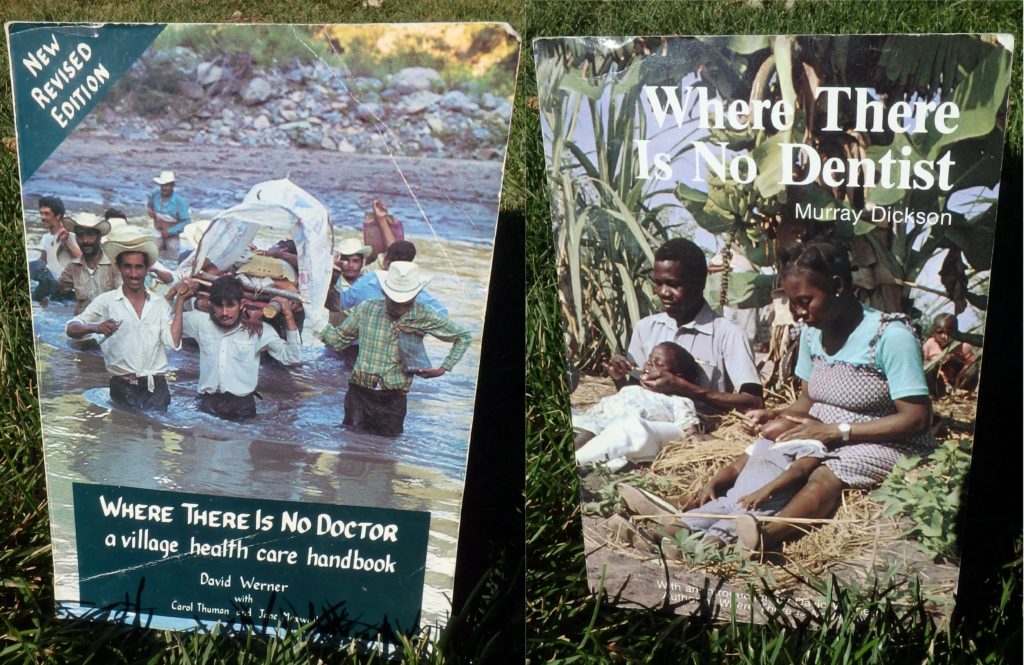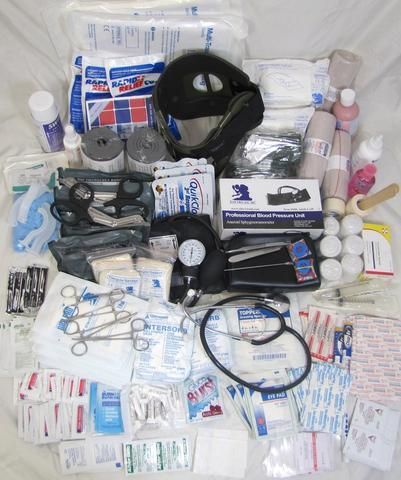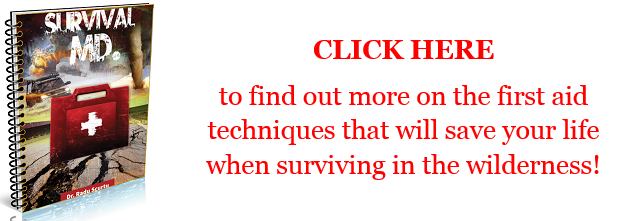As part of their emergency preparations, survivalists typically get their dental work caught up and prepare a dental first aid kit to help them deal with dental emergencies.
We don’t do this because it may be hard to find a dentist during the zombie apocalypse. We more often do it to save money and to be able to handle the odd dental emergency.
Investing in the capability to treat dental emergencies gives you a valuable skillset that makes you useful to your community. Even if dental professionals are available to render treatment in an emergency, you may need to provide your own supplies.
Keep your dental work current. It’s better to treat dental problems now, when professional help is available if needed. Because dental problems can become very serious, even life threatening, wisdom teeth are often removed around the age of eighteen before lengthy military or missionary service. This is done to prevent patients from having to deal with a swollen, infected jaw in an austere setting. Even after dental work is done, attention should be paid to dental hygiene. I’m sure it must be very disappointing to pass special forces selection and then to go combat ineffective because you failed to take care of your teeth, but this happens to scores of military personnel every year. Learn from their mistakes by getting your teeth in shape and keeping them that way.
I enjoy traveling and camping in austere settings, so it’s important to be able to handle dental emergencies in these settings. But, even if you never leave the city, most dentists don’t treat patients an emergency basis like a hospital emergency room, so most folks are on their own to handle dental emergencies until they are able to schedule an appointment.
Another reason people make alternative plans for dental work is that they don’t trust our bloated, overpriced dental healthcare system. Excessive regulation, pharmaceutical patents and shady politics mean Americans pay many times the prices citizens of other nations pay for the same procedure. Because of this, many Americans duck across the border to Canada or Mexico where they pay a fraction of the price for the same dental work. If you travel someplace that does quality dental work inexpensively, you might as well take advantage of it.
Although teeth are a part of a healthy human body, the US government doesn’t seem to think you need them. When it comes to dental care most of us are on our own.
Improvised Emergency Dental Care & Instruments
 If you saw the movie Castaway, you probably remember the scene where the protagonist extracted a tooth with a rock and an ice skate that he liberated from a FedEx package. A dental emergency in an austere survival ordeal can be a daunting proposition. Here are a few ideas on improvising dental instruments and care from pocket survival kit contents.
If you saw the movie Castaway, you probably remember the scene where the protagonist extracted a tooth with a rock and an ice skate that he liberated from a FedEx package. A dental emergency in an austere survival ordeal can be a daunting proposition. Here are a few ideas on improvising dental instruments and care from pocket survival kit contents.
- Wax – A candle stub of paraffin is something you may already carry in a pocket survival kit that can be a lifesaver if you break a tooth or loose a filling exposing a nerve to air. Heat the wax enough that it can be molded, roll a small piece into a little ball and tamp it into place with piece of wood carved for the purpose. The fix is only temporary, but wax can put a stop to the mind-numbing pain of an exposed nerve and prevent a broken tooth from cutting the mouth, lips or tongue which could soon become infected. Wax is also useful in preventing discomfort from orthodontic braces.
- Dental Mirror – It’s tough to diagnose what you can’t see, much less fix it, so a small inspection mirror is worth packing. In a pinch, a larger glass mirror can be broken into smaller pieces (about ¾” or 2cm). Grind down the sharp edges on any rock that contains quartz and glue it or affix it to a tongue depressor or stick and give it shallow bend.
- Sewing or Suture Needle – A sewing or suture needle can be bent into a hook and hafted to a short handle of wood or plastic for use as a dental pick.
- Lockpicks – Lock picks are the right size and shape to craft into emergency dental instruments and lockpick kits often include useless models to bump up the number of picks in the set and dupe inexperienced consumers. Stainless steel lockpicks are generally pretty cheap, so if your lockpick kit includes double or single ball picks, I wouldn’t hesitate to heat, bend and grind one them into anything useful, including a dental probe, spoon excavator, filling tool or a cement spatula.
- Medical Cotton – Medical cotton comes in many different forms. I prefer zig-zag folded sheets. Some instructors use makeup pads and still others use dental rolls. It really doesn’t matter too much because it’s easy to turn it into what you need.
- Potassium Permanganate – This potent chemical is very multiuse and is useful in tiny amounts, suiting it for inclusion in pocket survival kits. Diluted in water until the color is bright pink, potassium permanganate is an effective oral antiseptic to reduce infection. A slightly more concentrated red solution can be dabbed on canker sores.
- Dental Floss – Sure, depending on the spacing between your teeth, you may be able to use some type of thread as dental floss, but they aren’t nearly as effective. Because dental floss is so useful as cordage, you might as well carry a tiny spool. You can break open the plastic boxes that house dental floss, remove the tiny spool, apply a little vinyl tape (electrical tape) to it and toss one in your pocket survival kit. As you may know, strong cordage, such as dental floss, can also be used to extract teeth. Just tie a slip knot, place it around the tooth and tie the other end to a doorknob and shut the door. Lacking a door, any object that provides sufficient inertia will do.
- Toothbrush – A toothbrush can be improvised from any fibrous, non-toxic twig. Carve a toothpick on one end and chew the other into a brush. Barrel cactus spines can also be carved to make outstanding toothpicks.
- Toothpaste – Toothpaste is not necessary to clean your teeth. Charcoal or ash made from non-toxic species of wood, salt, baking soda or just plain old water can help.
- Z-pak – Azithromycin stands along amongst antibiotics as an entire course is just a half dozen or so small pills and can easily fit into a pocket survival kit. It’s also effective against dental infections and abscesses.
- Bandana – A cravat or bandana can be used to immobilize the jaw and hold a hot or cold compress in place.
Emergency Dental Kit
While it’s nice to know how to improvise dental tools in a dire emergency, a proper emergency dental kit will make treatment more effective and less painful. Many of the supplies and instruments needed for emergency dentistry are also useful in emergency medicine, making them doubly important. Review the following contents and customize them to your needs:
Reference
- Emergency Dental Text – I recommend Where There Is No Dentist by Murray Dickson of the Hesperian Foundation (now Hesperian Health Guides). Much of the material in this article comes from this text.
- Emergency Medical Text – There are many good ones, but Where There is No Doctor by David Werner is particularly useful for use by laymen in austere settings.
Medicines
- Aspirin 300mg Tablets – To control pain.
- Acetaminophen, 500mg Tablets – To control pain.
- Penicillin, 250mg Tablets – An antibiotic used to treat infection.
- Erythromycin, 250mg Tablets – An antibiotic used to treat infection.
- Nystatin Cream or Solution – Antifungal creme used to treat thrush and diaper rash.
- Epinephrine – Have on hand to counter allergic reactions to antibiotics and aspirin.
- Injectable Lidocaine 2% – Apply topical lidocaine, wait 5 minutes, inject, wait another 5 minutes and then test to ensure that the tooth is numb. If not, repeat the injection. The lower jaw is more difficult to numb than the upper jaw. Study injection sites carefully. Never inject an area that is swollen as it may spread the infection.
- Topical Lidocaine – To numb gums and injection sites.
- Injectable Procaine Penicillin, 300K Units per ml – For very severe infection. Injected into the buttocks or arm.
- Injectable Crystalline Penicillin, 1M Units per ml – A short-acting form of penicillin used to treat very severe infections such as septicemia, gangrene and meningitis and to prevent infection in compound fractures. Injected into the buttocks or arm.
- Oil of Cloves – Also known as eugenol, used to soak small pieces of cotton to relieve pain. Squeeze so the cotton is damp, but not wet. Too much will cause a burning sensation.
Instruments
General/Diagnostic – The following three instruments are needed for every dental procedure so buy extras if you may treat more than one patient at a time and bundle them in sets of three.
- Dental Mirror – Used to see the back sides of teeth and to retract and protect the cheeks, tongue and gums.
- Sickle Probe – Also known as a dental explorer, this probe is the most commonly used dental tool and its sharp point enhances tactile sensation and helps dentists feel the difference between healthy and unhealthy material and better diagnose dental maladies.
- Cotton Forceps – Used to handle cotton gauze and apply dressings in the confines of a mouth.
Injections
- Aspirating Dental Syringe – For injected medicines. Learn to give injections from an experienced healthcare worker.
Scaling Teeth
- Posterior Sickle Scaler – Use to scrape tartar from teeth. If your scaler is not sharp enough to cut into your fingernail, it must be sharpened.
- Periodontal Curette – For removing tartar below the gums.
Cement Fillings – Without the specialized tools and dental drills required for permanent fillings, you will be limited to less definitive treatments such as temporary fillings.
- Spoon Excavator – Used to excavate some (but not all) of the soft decay and break away weak material in preparation for a filling. If you dig too deep, you may damage the nerve and kill the tooth. All decay must be removed from the edge of the cavity, however.
- Filling Instrument – Used to place and smooth the filling.
- Cement Spatula – Used to mix the filling material.
Extracting Teeth – Most teeth can be extracted using the first three tools below and a spoon excavator. The other tools are useful in removing firmly rooted back molars.
- Straight Elevator – Use to lever teeth up. Use the jawbone as a fulcrum to lever teeth, not adjoining teeth or you may loosen or even break them.
- Upper Universal Forceps – Gently rock teeth back and forth to loosen them.
- Lower Universal Forceps – Don’t grip teeth too firmly with forceps. Teeth needing to be extracted are usually severely damaged and can break if too much pressure is applied.
- Left & Right Upper Molar Forceps
- “Hawk’s Bill” Lower Molar Forceps
- “Cow Horn” Forceps – Useful to get down in between the roots of molars.
- Curved “Cryers” Elevators – Useful to extract broken roots. If a root breaks off and is difficult to get out, stop and try again a week later.
Supplies
- Cotton Gauze – To make dressings. Also moistened with water to keep permanent teeth for replacement when knocked out.
- Dental Gauze Rolls – To make dressings and control bleeding. To dry teeth in preparation for a filling. Change cotton when it becomes wet.
- Zinc Oxide Powder – Mixed with oil of cloves to make temporary fillings for cavities. Practice mixing cement ahead of time. Teeth with temporary fillings are weak, so the patient must avoid exerting too much pressure on them when chewing.
- Concentrated Fluoride Water – Diluted and applied to gauze and packed around sensitive teeth to harden them. Do not swallow.
- Disposable Needles, 27ga Long – For injections.
- Wooden Tongue Depressors – To retract and protect the tongue, cheeks and gums.
- Salt – Used to make warm saltwater rinse to treat gum disease.
- 20ga Ligature Wire – Used to wire teeth together to hold them in place and to stop bleeding from fractures of the jaw between the teeth.
- Smooth Piece of Glass – For mixing fillings.
- Hydrogen Peroxide – Antiseptic.
- Concentrated Benzalkonium Chloride Solution – Topical antiseptic also used to clean instruments.
- Sharpening Stone – To sharpen instruments.
- Brush – To clean instruments before sterilization.
- Pressure Cooker – To sterilize instruments and gauze. Dry instruments after boiling and never store them wet. Sterilizing with heat is necessary any times instruments touch blood. Otherwise instruments can be sterilized with alcohol or bleach solution.










































































I just closed it out without watching. In the period of time, it took me to figure out my volume I tried to go back to watch it. However, to force people to not fast forward I also could not go back without starting all over. Get rid of this feature. I just turned mine off and feel a bit annoyed.
Hello!
thank you for your feedback, it really means a lot to us. We’ll have our team look into the problem and fix it ASAP!
Survivopedia team 🙂
Along with this kit, write out a sheet with contraindications and drug interactions.
if you know exactly what you need for dental instruments – good chance it’s available as a vet offering in the wholesale medical catalogs >>> http://www.shopMedVet.com has a good selection spanning quality & $$$$$ ….
I’ve heard of people using household glues to repair teeth.
Glues such as epoxy resin,wood glue or even superglue.
I’d be interested in comments about this or other emergency repairs for if recognised materials are not available.
E.g.-shell casing , wooden peg , tape , builders grout ,silicon sealant